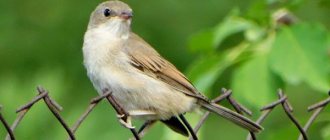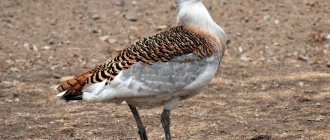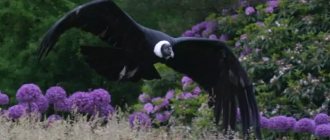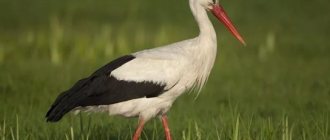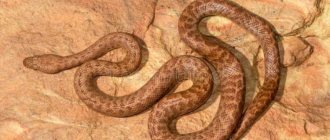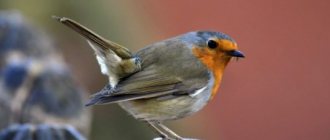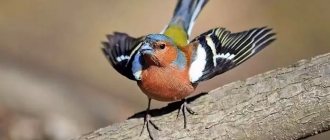Description of the bird
Why was it called that?
The nuthatch bird was so named because it crawls along the trunk, both up and down with its head. The word nuthatch comes from the verb crawl, crawl.
Appearance
— Advertising —
Nuthatches are characterized by a dense build with a large head and short neck. The beak is chisel-shaped, sharp, strong, straight, adapted for chiselling. There are stiff bristles at the base of the beak. The wings are short and rounded. The tail is short, wedge-shaped. The paws are short, very strong, with long, curved claws. The plumage is loose. The upper part of the body is gray or bluish-gray. The color of the abdomen is varied: white, fawn, ocher, red or chestnut are found. There is a cap of dark feathers on the head; some species have a dark stripe, a “mask,” over the eyes. The tail is bluish-gray with contrasting white and black spots. Juveniles look similar to adults, but their plumage is duller. The length of the smallest representative of the family, the brown-headed nuthatch, reaches 10.5 cm, the average weight is up to 10 g. The giant nuthatch, as the largest of the species, reaches 19.5 cm in length, and its weight is from 36 to 47 g. Most species in length up to 14 cm.
Male and female: differences
Sexual dimorphism in the nuthatch is insignificant. In some species the male is slightly larger than the female. In others, the color of the lower part of the body, in the area of \u200b\u200bthe sides and undertail changes, and the “eyebrows” on the face and the color of the crown and crown of the head vary.
Natural enemies
Nuthatches have many natural enemies among birds and mammalian predators. Adult birds are hunted by hawks, owls and martens. Chicks and clutches are threatened by the same owls and martens, as well as squirrels, crows and jays.
Return to content
What does a nuthatch eat?
During the breeding season, the nuthatch feeds mainly on animal food, and during the rest of the year it prefers plant food. So, in the spring and early summer, nuthatches eat insects and arthropods, which are found in bark cracks, rotten wood, and tree foliage. In late summer and autumn, nuthatches feed on juicy fruits, seeds of coniferous trees, acorns and nuts. The method of obtaining food makes nuthatches similar to woodpeckers, pikas, dart frogs and tree hoopoes. All these birds look for insects under the bark of trees and in its cracks; their beaks are adapted for chiselling, but only nuthatches do not use their tail as a support. Birds cling to trees and the surface of rocks with their strong clawed paws. Sometimes nuthatches descend to the ground in search of food, where they explore the soil and forest floor. Some of the nuthatch species make provisions for the winter; the birds hide seeds and other food in tree crevices, under bark and small pebbles, and remember the location of the hiding place for about a month. The nuthatch uses such reserves in bad weather, when there are no other sources of food.
Lifestyle and habitat
The nuthatch bird is active and restless. All day long, in search of food, it scurries along the trunks and branches of trees, making short flights. Distributed everywhere. Birds created settlements in most of Europe and Asia. They can be found in hot Morocco and the cold forest-tundra of Yakutia, in the Asian tropics.
In Russia, they more often settle in deciduous, mixed forests, and forest-park zones, where there are many bark beetles, wood borers, and leaf beetles. By eating pest beetles, the nuthatch prolongs the life of trees. Birds also settle in willow thickets, urban plantings, and in the Caucasus mountains.
to answer the question whether the nuthatch is a migratory bird or not . The majority are wintering. It is not without reason that each individual conscientiously stores up food supplies from autumn until the very cold, hiding nuts and seeds in secluded places in the nesting area.
The shaggy nuthatch lives in the south of the Korean Peninsula in winter, where it flies from Primorye. But this is rather an exception to the rule. If the birds are not disturbed, they stick to their area for years.
After the chicks grow up and leave the nest, families break up. Birds do not form specific flocks, but join tits and migrate with them over short distances in search of food.
The brave nuthatch calmly sits on feeders in winter, and in cold, stormy weather, if its supplies have been plundered by squirrels or chipmunks, it can easily fly into an open window. They willingly settle in small houses made for birds by humans, in city limits or in summer cottages.
They take root well at home. Spacious enclosures, close proximity to siskins and linnets, are suitable for them. The place of residence is equipped with twigs, swings, and rotten stumps. Bird watching is almost the same as attending an acrobat performance. With normal care and sufficient living space, a nuthatch in captivity is capable of producing offspring.
Spreading
Area
— Advertising —
Nuthatches are widespread in the northern hemisphere. The largest number of them live in Asia. In Europe, nuthatches also live almost everywhere. Thus, the range covers temperate climate zones from the Atlantic coast to the Pacific coast. Two species are found in the Atlas Mountains of northern Africa, Morocco and Algeria. The Canada nuthatch, brown-headed nuthatch, and little nuthatch are found in North America.
Habitats
Nuthatches choose places with a cool climate to live. Northern species live on plains, while southern species prefer mountains. In general, birds lead a sedentary lifestyle, and only occasionally make small migrations. Nuthatches are arboreal birds that live in coniferous evergreen forests, mountains or foothills. Some species are found in mixed or deciduous forests, woodlands and cultivated landscapes.
Is the nuthatch a migratory bird or not?
The nuthatch is a wintering bird that spends the winter in the forest (they do not fly south). Sometimes nuthatches are observed in the steppe zone, but more often the birds winter in coniferous forests. Ornithologists classify them as partly nomadic. As soon as spring comes, the birds move again to mixed and deciduous forests.
Kinds
Common nuthatch
The common nuthatch (Sitta europaea) is found in Europe, Asia and North Africa. This is a small, agile bird with a body length of 12 to 14.5 cm, a wingspan of 22.5 to 27 cm and a weight of 20-25 g. It has a dense build, a large head and a short neck. The plumage is fluffy and dense. Color varies in different regions of habitat. The upper body is usually colored bluish-gray. In western Europe, Asia and the Caucasus, the belly is red, and the chin and neck are white. In the north of the range, the belly is white with red sides and undertail with white streaks. There is a dark “mask” over the eyes. The beak is gray, long, straight, sharp. The wings are short and rounded. The tail is short and straight. Legs are grey-brown and strong. The male is slightly larger in size than the female.
- Latin name
: Sitta europaea - Kingdom
: Animals - Class
: Birds - Order
: Passeriformes - Family
: Nuthatches - Genus
: Nuthatches - Species
: Common nuthatch - Body length
: 14 cm - Wingspan
: 22.5–27 cm - Weight
: 17-28 g
Baby nuthatch
The length of the bird is up to 10 cm, and its weight is about 10 g. The plumage is bluish-gray on top, the belly is whitish, the crown is gray with a white spot on the back of the head.
- Latin name
: Sitta pygmaea - Kingdom
: Animals - Class
: Birds - Order
: Passeriformes - Family
: Nuthatches - Genus
: Nuthatches - Species
: Little nuthatch - Body length
: 11 cm - Wingspan
: 22.5–27 cm - Weight
: 9.3-11.4 g
The species is distributed from southern British Columbia to the western United States down to central Mexico. Lives in coniferous forests.
Corsican nuthatch
The bird is endemic to the coniferous forests of Corsica. Its body length is up to 12 cm. The head is small, the beak is short. The back is bluish-gray, the belly is gray-beige, only the throat is light, whitish. The male has a black crown and frenulum and a white eyebrow. The female has a gray crown and frenulum. Juveniles have dull plumage.
- Latin name
: Sitta whiteheadi - Kingdom
: Animals - Class
: Birds - Order
: Passeriformes - Family
: Nuthatches - Genus
: Nuthatches - Species
: Corsican nuthatch - Body length
: 12 cm - Wingspan
: 22.5–27 cm - Weight
: 11.8—14.4 g
Black-headed nuthatch
The body length of the species is up to 12.5 cm. The head is small, the beak is small. The upperparts are bluish-gray. The belly is dirty white and there is a red spot on the chest. There is a white “eyebrow” on the head, the crown is black.
- Latin name
: Sitta krueperi - Kingdom
: Animals - Class
: Birds - Order
: Passeriformes - Family
: Nuthatches - Genus
: Nuthatches - Species
: Corsican nuthatch - Body length
: 12.5 cm - Wingspan
: 22.5–27 cm - Weight
: 10—14.3 g
The species is sedentary and lives in the Caucasus, Turkey and the island of Lesbos.
Canadian nuthatch
The bird is colored bluish-gray on top, the belly is reddish, the face is white with black stripes on the eyes, the neck is white, the crown is black, and the beak is gray.
- Latin name
: Sitta canadensis - Kingdom
: Animals - Class
: Birds - Order
: Passeriformes - Family
: Nuthatches - Genus
: Nuthatches - Species
: Canadian nuthatch - Body length
: 11.5 cm - Weight
: 10-11 g
The species' habitat includes coniferous forests in Alaska, Canada and the northeastern and western United States.
Przewalski's nuthatch
The bird's body length is about 13 cm. The back is blue-violet or gray, the crown and back of the head are dark. The cheeks and throat are whitish-yellow, smoothly turning into a red breast and belly, the sides and undertail are chestnut-red.
- Latin name
: Sitta przewalskii - Kingdom
: Animals - Class
: Birds - Order
: Passeriformes - Family
: Nuthatches - Genus
: Nuthatches - Species
: Przewalski's nuthatch - Body length
: 12.5 cm - Weight
: 11-13 g
The species nests in China, in mountain coniferous forests at altitudes from 2250 to 4500 m above sea level.
Carolina nuthatch
The body length of the species is from 11 to 18 cm, the weight is 20-40 g, the wingspan is from 22.5 to 27 cm. The body is dense, the head is large, and the neck is short. The beak is chisel-shaped, sharp, strong.
- Latin name
: Sitta carolinensis - Kingdom
: Animals - Class
: Birds - Order
: Passeriformes - Family
: Nuthatches - Genus
: Nuthatches - Species
: Carolina nuthatch - Body length
: 15.5 cm - Weight
: 19.6—22.9 g
The species lives in North America, from southern Canada to Mexico, in deciduous and mixed forests, as well as gardens and parks.
Lesser rock nuthatch
Outwardly it resembles a common nuthatch. Distributed in southeastern Europe, Turkey, Syria, Israel, Iran. It prefers to live among rocks, on steep cliffs, near ravines.
- Latin name
: Sitta neumayer - Kingdom
: Animals - Class
: Birds - Order
: Passeriformes - Family
: Nuthatches - Genus
: Nuthatches - Species
: Lesser rock nuthatch - Body length
: 13-13.5 cm - Weight
: 24-37.6 g
Greater rock nuthatch
The body length of the bird is from 15 to 16 cm. The weight ranges from 42.7 to 55 g. The back is gray, the belly is white with a reddish tint on the sides. There is a black “mask” over the eyes.
- Latin name
: Sitta tephronota - Kingdom
: Animals - Class
: Birds - Order
: Passeriformes - Family
: Nuthatches - Genus
: Nuthatches - Species
: Great rock nuthatch - Body length
: 15-16 cm - Weight
: 42.7-55 g
The species' habitat includes Transcaucasia, Central and Central Asia.
Black-fronted nuthatch
The bird's body length is about 12.5 cm, the head is large, the tail is short, and the beak is strong. The back is blue-violet, the cheeks are lavender. The belly is beige, the chest is whitish. The beak is red and there is a black spot on the forehead. The male has black eyebrows, the female does not. Juveniles are dull.
- Latin name
: Sitta frontalis - Kingdom
: Animals - Class
: Birds - Order
: Passeriformes - Family
: Nuthatches - Genus
: Nuthatches - Species
: Black-fronted nuthatch - Body length
: 12.5 cm - Weight
: 8.5-17 g
The species is found in India, Sri Lanka, southern China and Indonesia, living in evergreen forests.
Nuthatch breeding
Forest nuthatches make their nests in hollows, lining them with grass and leaves. Nuthatches also bring wood dust, bark, moss, wool and feathers to the nest. Some species excavate cavities on their own, but most nuthatches occupy the old cavities of other birds. Nuthatches camouflage the entrance to the hollow with earth or clay. Rock nuthatches make nests on rocky surfaces from soil or clay, adding droppings, fur and feathers. Nuthatches are monogamous birds and reach sexual maturity in the first year of life. The clutch contains from 4 to 14 white eggs with reddish-brown or yellow spots. Incubation from 12 to 18 days is carried out exclusively by the female. The chicks are born in downy plumage, helpless, and are fed by both parents. They begin to fly at the age of 18 to 25 days. But they remain close to their parents for a few more weeks, after which they begin an independent life.
Nuthatch interesting facts
- The Cherokee, an indigenous people of North America, called the nuthatch a deaf bird due to the fact that it is not afraid of human presence. Legend says that these people lived in six settlements, one of which was located in the forest and was called Bird's, as the nuthatch often flew into it and stole the food supplies of squirrels and rodents.
- Pliny the Elder in Natural History writes that people began to build clay houses following the example of swallows and rock nuthatches.
Riddles for children
A dark eyebrow, a red-haired flank, between tits and woodpeckers, circling like a top, upside down along the trunks - guess who he is? (Nuthatch)
***
He stubbornly drags acorns, nuts, grains into the hollows of linden trees, like a real storekeeper. A lively coachman. (Nuthatch)
***
The bird is noisy and whistles. His nickname was the coachman. Grabs a beetle in its beak - food. It crawls back and forth along the trunks all day long They call it... (Nuthatch)
***
Trees heal every day. It climbs along branches and trunks. Trees are still much better when they are restless. And in a short age, He loves only one wife. They are registered in the hollow... They are alive with care... (Nuthatch).
Movement speed
These birds can be safely called very fast, especially during the period of raising offspring. They scurry back and forth all day in search of food for themselves and their ever-hungry offspring. And I must say that nuthatch chicks are very voracious. Therefore, these birds can be safely classified as hardy representatives of the animal world.
Nuthatch preparing to nest
Question answer
- Is the nuthatch flying to warmer climes? - No, these are wintering birds.
- What does a nuthatch eat? — In summer it feeds on animal food (insects, midges, etc.), in winter on plant food (seeds, nuts, etc.).
- Why is the nuthatch called the Coachman? — First version: because of the voice. While searching for food, it makes frequent short whistles “tew-tew-tew”, and sometimes “ttsit” or longer “ttsi-it”, which is why they were once called “coach drivers”. Second version: because of character. The bird's character is lively and perky, reminiscent of the behavior of Yamshchikov (Kucherov on pit horses).
- What is the nuthatch's nickname? — The bird has two nicknames: the first is “Coachman”, the second is “Crawler”.
- How to spell pl syllables? - The word has 3 syllables “nuthatch” syllable by syllable: po-pol-zen.
- Is the nuthatch flying south or not? - no, the bird does not fly south.
Nutrition
In spring and summer, the coachman's diet is dominated by insects. This especially applies to the period of nesting and feeding chicks.
Protein nutrition includes:
- larvae, caterpillars;
- small arachnids;
- pest beetles (weevils, leaf beetles);
- flies, midges;
- worms;
- ants;
- bedbugs
More often, the nuthatch hunts for insects by deftly running along tree trunks and branches. But sometimes it descends to the ground, looking for food in the grass and forest turf. In autumn, birds love to eat bird cherry, hawthorn, and rose hips. The main plant diet consists of conifer cone seeds, beech and glen nuts, acorns, barley and oats.
Nuthatches are almost not afraid of people and are often found near feeders
According to the observations of ornithologists, the nuthatch has a good sense of smell; it will never be interested in an empty nut. It skillfully pierces the hard skin with a sharp, strong beak, pressing the fruit to the surface of the trunk, holding it with its paw, or placing it in a rocky crevice.
In winter, brave birds come to man-made feeders. When looking for food, they are not afraid to even sit on a hand with seeds or other treats. From autumn to December, crawlers create food reserves, placing nuts and seeds along cracks in the bark or hollows in different places so that the supplies do not disappear all at once.

